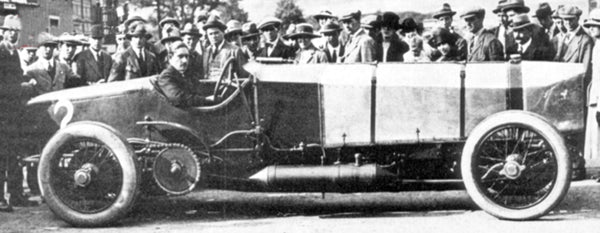“Never say ‘No’ to adventure. Always say ‘Yes’, otherwise you’ll lead a very dull life”….. Commander Pott, Chitty Chitty Bang Bang
All of us have heard of the children’s book and movie Chitty Chitty Bang Bang written by Ian Fleming, famous for his James Bond novels. But did you know Chitty Chitty Bang Bang was based on a real life car and a real life character? Following is the story of the original Chitty Bang Bang, the story behind the story.
Motor racing in the early 1900’s was a very aristocratic affair. Many Counts, Barons and Lords took part in this very dangerous sport, many losing their lives.
One of the more wealthy competitors was Count William Eliot Morris Zborowski. In 1881, at the age of 23, Count Eliot Zborowski inherited one third of his father’s estate (estimated to be in excess of £44 Million). Eliot was not interested in following in his father’s footsteps of property and business investments. He simply wanted a life of pleasure.
By 1902, Count Eliot had purchased a Mercedes 40HP that he entered into the first Paris to Vienna Motor Race. Although he was first to cross the finish line, the Automobile Club de France penalized him by 30 minutes on a technical point regarding Customs formalities, therefore enabling a French Panhard, driven by Frenchman Henri Farman, to take first place.
In April 1903, Zborowski entered his new Mercedes 60HP car in the La Turbie Hill Climb. This was a South of France event, from Nice to La Turbie on the dangerous Corniche Road. Despite being warned by a fortune teller not to enter, he persisted in taking part. He was the fifth car to leave the start line and sadly at the first bend his car rolled and killed him instantly. It is believed his cuff link got caught in the hand throttle (no foot pedals in those days), forcing it fully open.
After the accident, his wife Countess Margaret and 8 year old son, Count Louis Vorow Zborowski moved to England. In 1911, the Countess passed away leaving the 16 year old Count Louis Zborowski to be the fourth wealthiest under-21year old in the world. He inherited £11 million in cash, seven acres of real estate in Manhattan, several large blocks of land on Fifth Avenue New York, along with other real estate in England.
Following in his father’s footsteps, Count Louis had a passion for motor cars. He owned numerous racing cars including a 1914 Mercedes G.P and 1919 Ballot Straight Eight, however, he had the yearning to build his own cars. With the help of an engineering friend, Captain Clive Gallop, who had been trained at Peugeot in France before the First World War, he built four aero engine cars, three of which were called Chitty Bang Bang.

Zborowski purchased a 6 cylinder 23,093cc Maybach Zeplin aero engine from the Aircraft Disposal Company. This was the power plant for Chitty Bang Bang 1. The enormous engine was ‘shoe-horned’ into a lengthened Mercedes 75 HP chassis. The Mercedes radiator, clutch and gearbox were retained along with the rear axle that was driven by side chains. The braking system was rear brakes only! To give the car sufficient ground clearance, the Maybach oil sump was removed and a dry-sump system was designed using a large reservoir mounted on the side of the chassis.

Chitty Bang Bang 1 - a lengthened Mercedes 75 HP fitted with a 6 cylinder Maybach Zeplin aero engine
The car was first raced at Brookland at Easter 1921. To register the car to race, Zborowski needed a name, so he called the car Chitty Bang Bang. Many thought this was due to the noise it made when starting. Zborowski had a wicked sense of humour and apparently the real reason was that during the WW1, British soldiers in France received a ‘chit’ for weekend leave and they all headed to Paris to spend time with the ‘ladies of the night’. Hence the name, Chitty Bang Bang!
The car caused quite a sensation at its first appearance at Brookland, not only due to shear gigantic size, but also because of the rigmarole in staring the engine. Using a half axle, from an old WW1 B.E. aircraft as an extension of the crank handle, the mechanic had enough leverage, with the aid of someone inside the car furiously winding the dashboard starting magneto, to turn the engine over. It created quite an audience.
At the first outing, it was found that although the chassis had been strengthened with bracing rods, handling still left a lot to be desired. To keep the back wheels on the ground during cornering, 7cwt (350kgs) of sand was placed in the back of the car!
Chitty’s first race on Easter Monday 28th March 1921 saw her handicapped by 78 seconds. Zborowski averaged 100.75 mph to win his first race.
Zborowski and Chitty Bang Bang continued to rack up race wins. At the 1921 Brookland Summer Meeting, Zborowski left from the scratch mark in the Lightning Short Handicap and took out second place behind Ernie Swain in a G.P. Vauxhall.
In September 1922, at the Essex M.C. Championship Meeting, Zborowski was lapping extremely fast during practice. When approaching the Members banking, the off side front tyre blew and Chitty struck the parapet at the top of the track, spun around, slid down the bank and went backwards through the wooden timing hut. The front axle was torn from the car. The riding mechanic, Len Martin, was thrown out (he was badly shaken but unhurt); while Zborowski stayed in his seat and fortunately escaped without serious injury. However, the same can’t be said for the timing official in the wooden timing hut. He lost three fingers when Chitty smashed through the wooden building. Another official saw the car coming at him and jumped into a ditch, just as Chitty flew over his head! This was the last time Zborowski raced Chitty Bang Bang 1.
By 1924, Zborowski was a driver for the Works Mercedes Racing team, following in the footsteps of his father. At the Italian Grand Prix in October 1924, on the 44th lap at Lesmo Corner, Count Louis Zborowski lost control of his car, hit a tree, and was killed instantly. The remaining 3 Mercedes were withdrawn from the race. On the day Count Louis Zborowski died, it is believed he was wearing the exact same cuff links his father Count Eliot Zborowski wore when he had his fatal accident.
Prior to his death, Zborowski rebuilt Chitty Bang Bang 1 and sold it to his neighbour Captain J.E.P. Howey. Howey sold Chitty to the sons of Sir Arthur Ignatius Conan Doyle (the Scottish physician and famous writer of Sherlock Holmes novels). They entered Chitty in a speed trial in 1930 and then retired her to a garage in London. In 1934, Chitty Bang Bang was part of an exhibition of old racing cars at Brookland. After the exhibition Chitty’s owners parked her on the grass at the racing circuit hoping to attract a buyer. After sometime, in a sorry state, Chitty was finally purchased, however, the new owner only wanted to salvage her gearbox. In doing so, they demolished the chassis and completely destroyed Chitty Bang Bang 1.
Copyright © 2018 carmanualsdirect.com

